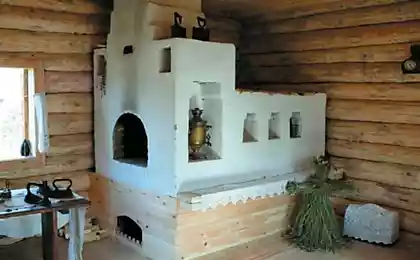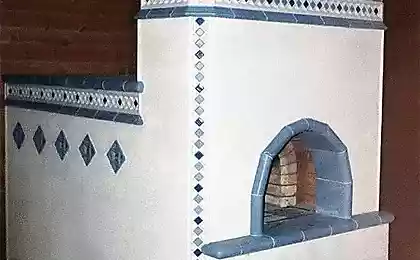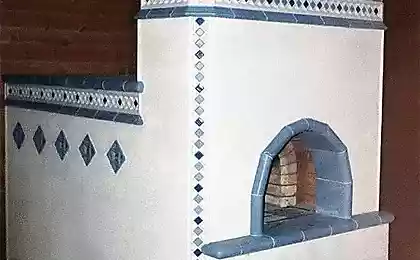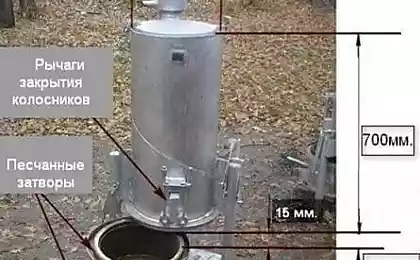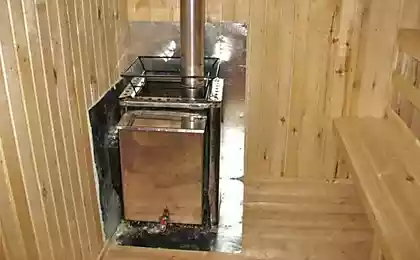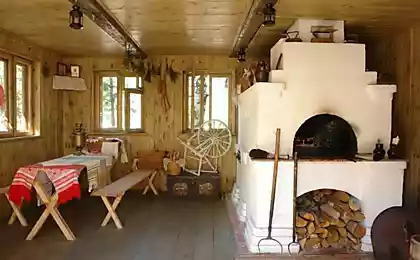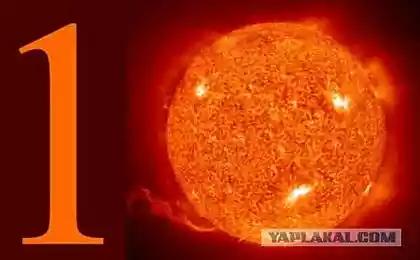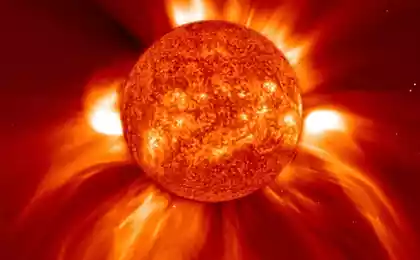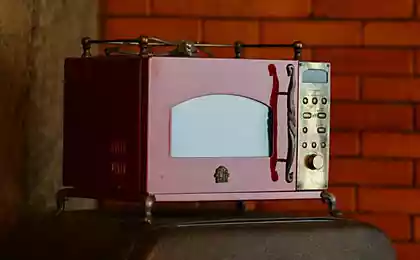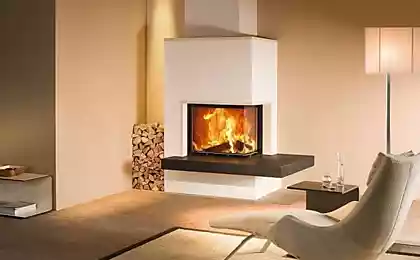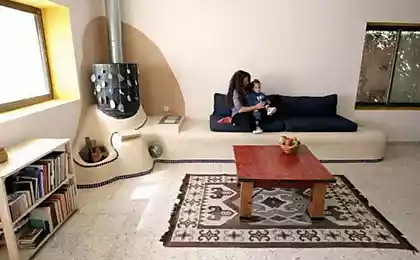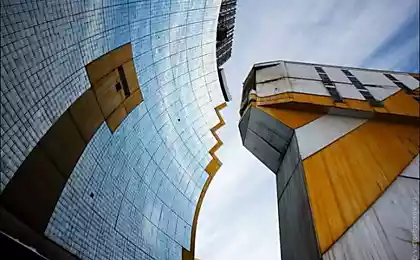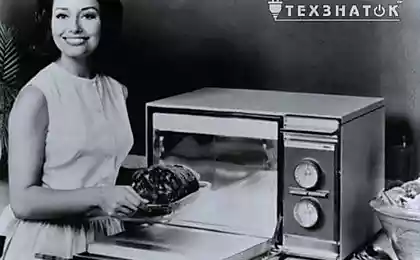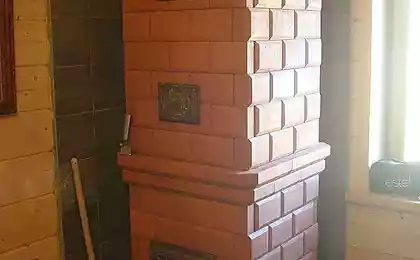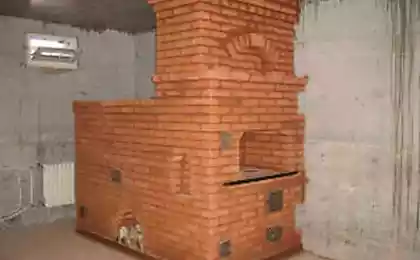641
How to make a solar oven
The successful use of solar stoves (plates) was noted in Europe and India in the 18th century. Solar cookers and ovens absorb solar energy and convert it into heat that accumulates inside a closed space. Absorbed heat is used for boiling, frying and baking. Temperature in a solar oven can reach 200 degrees Celsius.
Box solar oven
Box solar cooker comprises a well insulated box, painted the inside black, which is placed in black pots with food. Two-layer box serves as a "window" which passes solar radiation into the box and keeps the heat inside. In addition to it is attached a lid with a mirror on the inside, which, when thrown, increases the incident radiation, and in a closed form improves thermal insulation of the furnace.
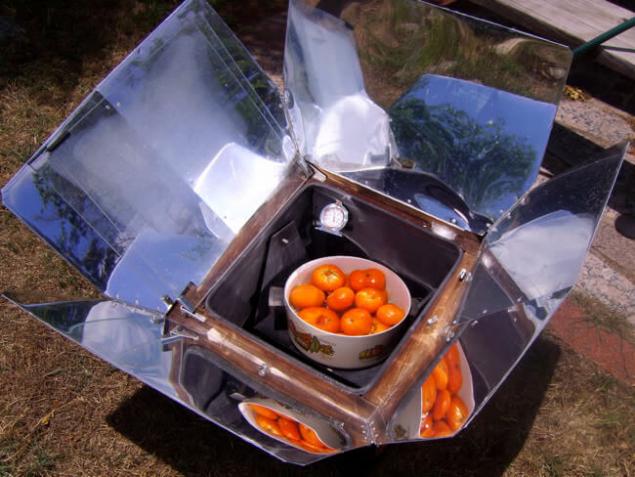
The main advantages of solar box ovens:
Recommendations for the construction of a solar oven
As the heat absorbed by the inner surface of the box, should be transferred to pots, the best material for boxes — aluminum with high conductivity. In addition, aluminium does not corrode. For example, a steel box, even with galvanic coating could not long withstand the hot and humid environment inside the furnace in the cooking process. Sheet copper is too expensive.
The outside of the box you can't attach the metal parts, which can create thermal bridges. The insulating material can be glass, synthetic wool or some natural material (husk of peanuts, coconuts, rice, corn, etc.). Whichever material is used, it needs to stay dry.
Oven cover can consist of one or two glasses with air gap. The distance between the two layers of glass is usually 10-20 mm. Studies have shown that the use of a transparent material with cellular structure, which divides the inner space into small vertical cell, can significantly reduce the heat loss of the furnace, thus increasing its effectiveness. The inner glass is exposed to thermal influence, so often used tempered glass; or both layers can consist of ordinary glass with a thickness of about 3 mm.
The outer cover of the solar oven is a reflector that amplifies the incident radiation. The reflecting surface can serve as the an ordinary glass mirror, a plastic sheet with a reflective coating or unbreakable metal mirror. In a pinch, you can use the foil from cigarette packs.
External box solar oven can be made of wood, fiberglass or metal. Fiberglass is lightweight, inexpensive and water resistant, but not very durable in continuous use. Wood is stronger, but heavier and more prone to damage due to humidity. Aluminum sheets combined with wooden bracket form the high-quality surface resistant to mechanical shocks, temperature changes and humidity. Reinforced aluminium wooden box the most durable, but it is more expensive and quite heavy, in addition, its production requires time.
Performance standard solar furnaces with an area of 0.25 m2 aperture is about 4 kg of food per day, i.e. sufficient for a family of five.
Peak temperature inside a solar oven can reach more than 150C on a Sunny day in the tropics; this is approximately 120 ° C above the ambient temperature. As the water contained in the food, not heated above 100 OC, the temperature inside the furnace is always filled will be correspondingly lower.
The temperature in the solar furnace is dramatically reduced when she placed the dishes with food. It is also important that the temperature remains significantly below 100 OS most of the time cooking. But the boiling point is 100 OS not needed for cooking most vegetables and cereals.
The average time of cooking in a solar oven is 1-3 hours, in good solar conditions and moderate load. The use of thin-walled aluminium pots and pans greatly reduces the cooking time compared to stainless steel kitchenware. In addition, influenced by the following factors:
The simplest mirror furnace is a parabolic reflector and a stand for the pots, is the focus of a furnace. If the oven is exposed to the Sun, sunlight is reflected from all reflector center point (focus), heating the pan. The reflector can be a paraboloid, made for example from sheet steel or reflective foil. Reflective surface usually made of polished aluminum, mirror, metal or plastic, but may also consist of many small flat mirrors attached to the inner surface of a paraboloid. Depending on the desired focal length, the reflector may be in the form of a deep bowl that completely immersed the pot of food (short focal length, utensils protected from the wind) or small plates, if the pot is set at the focal point at a certain distance from the reflector.
All ovens reflectors use only direct solar radiation and must therefore turn around the Sun. This complicates their operation, since it puts the user in dependence on the weather and control devices.

The advantages of reflecting furnaces:
Thermal power
Thermal power of the solar furnace is determined by the amount of solar radiation, absorption of the working surface of the oven (usually between 0,25 m2 and 2 m2) and its thermal efficiency (usually 20-50%). The table compares typical values of area, performance and power for the box of stove and stove-reflector.
Standard area values, efficiency and performance box furnace, and furnace-reflector
Area, m2
The average efficiency, %
Power, W at an illumination of 850 W/m2
Time for boiling 1 litre of water, min.
Reflector
1,25
30
320
17
Box oven
0,25
40
85
64
Usually the stove-reflectors have a much greater working surface than box. Therefore, they are much more powerful, they can boil more water, cook more food, or to process a comparable amount over a shorter period of time. On the other hand, their thermal efficiency is lower because the cookware cools under the influence of the atmosphere.
In tropical and subtropical countries, you can count on clear weather and normal daily light almost all year round. Around noon, when the total sunlight is about 1000 W/m2, it is realistic to rely on the heat capacity of 50-350 watts, depending on the type and size of the plate. The amount of radiation in the morning and in the afternoon is naturally lower and cannot fully compensate the system for tracking the Sun.
For comparison, burning 1 kg of dry wood produces approximately 5000 watts multiplied by the thermal efficiency of the plate (15% for primitive hearth and 25-30% for improved stoves used in developing countries). Thermal power actually reaching the detergent, is, thus, 750-1500 watts.
The amount of solar radiation decreases sharply when the cloud cover in the rainy season. In conditions of lack of direct radiation solar oven unusable for anything except storage of prepared food in the form of heat. The weak point of the solar furnace (regardless of their type) is that in cloudy and rainy days (2-4 months per year for most developing countries) food have to cook by conventional means: on firewood, gas or kerosene burner.
Solar radiation and furnace
The main precondition for the successful use of a solar oven is an adequate illumination with a small number of cloudy days during the year. The duration and intensity of solar radiation should allow the use of solar furnace for prolonged periods. While in Central Europe the cooking with solar energy is possible on a Sunny summer day, solar oven preferably the minimum amount of solar energy of 1500 kWh/m2 per year (corresponding to an average daily insolation of 4 kWh/m2). But the average figures can sometimes be misleading. An essential condition for the suitability of solar oven is a stable summer weather that is regular, predictable periods of cloudless days.
Solar energy resources in different countries vary substantially, even within the tropical zone in countries of the third world. For example, solar radiation in most regions of India is considered very good from the point of view of using solar energy. The average amount of solar energy is 5 to 7 kWh/m2 / day depending on the region. In most parts of the country the illuminance reaches a minimum during the rainy season, and almost as low during December and January.
The climate and solar potential of Kenya favourable for the use of solar furnaces. Kenya is located close to the equator and therefore has a tropical climate. In the capital, Nairobi, the amount of solar energy is 3.5 kWh/m2 / day in July to 6.5 kWh/m2 / day in February, and in other areas remains virtually unchanged (6,0 — 6,5 kWh/m2 per day in the province of Lodwar). Solar radiation in Nairobi allows you to cook food with solar energy nine months out of the year (except June-August). On the other hand, in the cloud or foggy days we have to rely on traditional fuels. However, in the province of Lodwar solar ovens can be used all year round.
Solar oven for developing countries
The purpose of the use of solar ovens, of course, is energy saving double energy crisis: the crisis of the poor, namely, the increasing shortage of firewood, and the crisis of the national energy — increasing pressure on its balance of payments.
In comparison with other countries, developing countries consume very little energy. For example, the rate of energy consumption per capita in India in 1982 — 7325 GJ — was one of the lowest in the world. But the level of energy consumption in this country is growing almost twice faster than its gross national product. The same thing is happening in other developing countries.
The majority of the population of developing countries receives the major part of consumed energy from non-commercial sources: from traditional local energy resources, through their physical labour. They just can't afford to buy the desired number of commercially produced energy.
The logical consequence is a relative shortage of fuel for the poor, whose standard of life is deteriorating even further. A solar oven is a step towards improving their living conditions.
Of all the "poor majority" of the inhabitants of third world countries, a solar oven must first be used by the rural population.
How much energy you need for cooking
Daily need for fuel depends on which food is prepared and it is quantity. A resident of a developing country to burn, on average, 1 ton of wood per year. A typical Indian family needs 3 to 7 kg of firewood per day; in the cooler regions daily amount of firewood for one family is nearly 20 kg in winter and 14 kg in the summer. In the South of Mali, the average family (consisting of 15 persons) burns about 15 kg of firewood per day. A study conducted in Afghan refugee camps in Pakistan showed that the daily need for firewood there is up to 19 kg per family. More than half of the wood in a typical household goes to the baking of bread, the rest for cooking another food. In winter, of course, wood requires more.
Despite the fact that the amount of energy needed for cooking is different, the solar ovens provide significant energy savings. The primary task of the solar furnaces — reducing the need for firewood, which are still the most important fuel for cooking. The problem is that the wood is inexpensive in comparison with kerosene, bottled gas and electricity. The increasing, uncontrolled felling of trees for their own use and for sale is the main reason for the disappearance of forests, expansion of deserts, soil erosion, declining groundwater level, and has long-term adverse effect on ecological balance. The few remains of forests in Pakistan and rampant deforestation in Kenya are proof that the fears about this are not exaggerated.
In General, the solar ovens are unlikely to make a major contribution to national energy. However, they could greatly improve the living conditions of the poor, to help them overcome a personal energy crisis.
Solar ovens come in different shapes and sizes. Here are some examples: oven, oven-hub, reflector, solar steamer apparatus, etc. for all the variety of models, all ovens trap heat and hold it in insulated chamber. In most models the sunlight acts directly on the food.
published
Source: rea.org.ua/dieret/Solar/solar.html#SOLAR COOKERS
Box solar oven
Box solar cooker comprises a well insulated box, painted the inside black, which is placed in black pots with food. Two-layer box serves as a "window" which passes solar radiation into the box and keeps the heat inside. In addition to it is attached a lid with a mirror on the inside, which, when thrown, increases the incident radiation, and in a closed form improves thermal insulation of the furnace.

The main advantages of solar box ovens:
- Use both direct and diffuse solar radiation.
- They can heat several pots simultaneously.
- They are lightweight, portable and easy to handle.
- They don't need to turn to follow the Sun.
- Moderate temperatures make stirring is not required.
- The food stays warm all day.
- They are easy to produce and repair using local materials.
- They are relatively inexpensive (compared to other types of solar ovens).
- You can use them to cook during daylight hours only.
- For moderate temperature cooking requires a long time.
- Glass cover causes considerable heat losses.
- These ovens "can not" fry.
Recommendations for the construction of a solar oven
As the heat absorbed by the inner surface of the box, should be transferred to pots, the best material for boxes — aluminum with high conductivity. In addition, aluminium does not corrode. For example, a steel box, even with galvanic coating could not long withstand the hot and humid environment inside the furnace in the cooking process. Sheet copper is too expensive.
The outside of the box you can't attach the metal parts, which can create thermal bridges. The insulating material can be glass, synthetic wool or some natural material (husk of peanuts, coconuts, rice, corn, etc.). Whichever material is used, it needs to stay dry.
Oven cover can consist of one or two glasses with air gap. The distance between the two layers of glass is usually 10-20 mm. Studies have shown that the use of a transparent material with cellular structure, which divides the inner space into small vertical cell, can significantly reduce the heat loss of the furnace, thus increasing its effectiveness. The inner glass is exposed to thermal influence, so often used tempered glass; or both layers can consist of ordinary glass with a thickness of about 3 mm.
The outer cover of the solar oven is a reflector that amplifies the incident radiation. The reflecting surface can serve as the an ordinary glass mirror, a plastic sheet with a reflective coating or unbreakable metal mirror. In a pinch, you can use the foil from cigarette packs.
External box solar oven can be made of wood, fiberglass or metal. Fiberglass is lightweight, inexpensive and water resistant, but not very durable in continuous use. Wood is stronger, but heavier and more prone to damage due to humidity. Aluminum sheets combined with wooden bracket form the high-quality surface resistant to mechanical shocks, temperature changes and humidity. Reinforced aluminium wooden box the most durable, but it is more expensive and quite heavy, in addition, its production requires time.
Performance standard solar furnaces with an area of 0.25 m2 aperture is about 4 kg of food per day, i.e. sufficient for a family of five.
Peak temperature inside a solar oven can reach more than 150C on a Sunny day in the tropics; this is approximately 120 ° C above the ambient temperature. As the water contained in the food, not heated above 100 OC, the temperature inside the furnace is always filled will be correspondingly lower.
The temperature in the solar furnace is dramatically reduced when she placed the dishes with food. It is also important that the temperature remains significantly below 100 OS most of the time cooking. But the boiling point is 100 OS not needed for cooking most vegetables and cereals.
The average time of cooking in a solar oven is 1-3 hours, in good solar conditions and moderate load. The use of thin-walled aluminium pots and pans greatly reduces the cooking time compared to stainless steel kitchenware. In addition, influenced by the following factors:
- Cooking time is reduced in conditions of high light and Vice versa.
- High ambient temperature reduces the cooking time and Vice versa.
- A small amount of food at one cooking reduces the cooking time and Vice versa.
The simplest mirror furnace is a parabolic reflector and a stand for the pots, is the focus of a furnace. If the oven is exposed to the Sun, sunlight is reflected from all reflector center point (focus), heating the pan. The reflector can be a paraboloid, made for example from sheet steel or reflective foil. Reflective surface usually made of polished aluminum, mirror, metal or plastic, but may also consist of many small flat mirrors attached to the inner surface of a paraboloid. Depending on the desired focal length, the reflector may be in the form of a deep bowl that completely immersed the pot of food (short focal length, utensils protected from the wind) or small plates, if the pot is set at the focal point at a certain distance from the reflector.
All ovens reflectors use only direct solar radiation and must therefore turn around the Sun. This complicates their operation, since it puts the user in dependence on the weather and control devices.

The advantages of reflecting furnaces:
- The ability to reach high temperatures and consequently faster cooking.
- A relatively inexpensive model.
- Some of them can serve also for baking.
- Depending on the focal length, the furnace needs to turn around the Sun approximately every 15 minutes.
- Use only direct radiation, diffused solar light is lost.
- Even with a small cloud of possible large losses of heat.
- Treatment with a stove requires a certain skill and understanding of the principles of its action.
- Reflected by the reflector radiation very bright, blinding, and can result in burns upon contact with the focal spot.
- Cooking is limited to daytime hours.
- Cooks have to work in the hot sun (except furnaces with fixed focus).
- The efficiency of the blast furnace largely depends on the changing strength and direction of the wind.
- A dish prepared in the afternoon, the evening cools.
Thermal power
Thermal power of the solar furnace is determined by the amount of solar radiation, absorption of the working surface of the oven (usually between 0,25 m2 and 2 m2) and its thermal efficiency (usually 20-50%). The table compares typical values of area, performance and power for the box of stove and stove-reflector.
Standard area values, efficiency and performance box furnace, and furnace-reflector
Area, m2
The average efficiency, %
Power, W at an illumination of 850 W/m2
Time for boiling 1 litre of water, min.
Reflector
1,25
30
320
17
Box oven
0,25
40
85
64
Usually the stove-reflectors have a much greater working surface than box. Therefore, they are much more powerful, they can boil more water, cook more food, or to process a comparable amount over a shorter period of time. On the other hand, their thermal efficiency is lower because the cookware cools under the influence of the atmosphere.
In tropical and subtropical countries, you can count on clear weather and normal daily light almost all year round. Around noon, when the total sunlight is about 1000 W/m2, it is realistic to rely on the heat capacity of 50-350 watts, depending on the type and size of the plate. The amount of radiation in the morning and in the afternoon is naturally lower and cannot fully compensate the system for tracking the Sun.
For comparison, burning 1 kg of dry wood produces approximately 5000 watts multiplied by the thermal efficiency of the plate (15% for primitive hearth and 25-30% for improved stoves used in developing countries). Thermal power actually reaching the detergent, is, thus, 750-1500 watts.
The amount of solar radiation decreases sharply when the cloud cover in the rainy season. In conditions of lack of direct radiation solar oven unusable for anything except storage of prepared food in the form of heat. The weak point of the solar furnace (regardless of their type) is that in cloudy and rainy days (2-4 months per year for most developing countries) food have to cook by conventional means: on firewood, gas or kerosene burner.
Solar radiation and furnace
The main precondition for the successful use of a solar oven is an adequate illumination with a small number of cloudy days during the year. The duration and intensity of solar radiation should allow the use of solar furnace for prolonged periods. While in Central Europe the cooking with solar energy is possible on a Sunny summer day, solar oven preferably the minimum amount of solar energy of 1500 kWh/m2 per year (corresponding to an average daily insolation of 4 kWh/m2). But the average figures can sometimes be misleading. An essential condition for the suitability of solar oven is a stable summer weather that is regular, predictable periods of cloudless days.
Solar energy resources in different countries vary substantially, even within the tropical zone in countries of the third world. For example, solar radiation in most regions of India is considered very good from the point of view of using solar energy. The average amount of solar energy is 5 to 7 kWh/m2 / day depending on the region. In most parts of the country the illuminance reaches a minimum during the rainy season, and almost as low during December and January.
The climate and solar potential of Kenya favourable for the use of solar furnaces. Kenya is located close to the equator and therefore has a tropical climate. In the capital, Nairobi, the amount of solar energy is 3.5 kWh/m2 / day in July to 6.5 kWh/m2 / day in February, and in other areas remains virtually unchanged (6,0 — 6,5 kWh/m2 per day in the province of Lodwar). Solar radiation in Nairobi allows you to cook food with solar energy nine months out of the year (except June-August). On the other hand, in the cloud or foggy days we have to rely on traditional fuels. However, in the province of Lodwar solar ovens can be used all year round.
Solar oven for developing countries
The purpose of the use of solar ovens, of course, is energy saving double energy crisis: the crisis of the poor, namely, the increasing shortage of firewood, and the crisis of the national energy — increasing pressure on its balance of payments.
In comparison with other countries, developing countries consume very little energy. For example, the rate of energy consumption per capita in India in 1982 — 7325 GJ — was one of the lowest in the world. But the level of energy consumption in this country is growing almost twice faster than its gross national product. The same thing is happening in other developing countries.
The majority of the population of developing countries receives the major part of consumed energy from non-commercial sources: from traditional local energy resources, through their physical labour. They just can't afford to buy the desired number of commercially produced energy.
The logical consequence is a relative shortage of fuel for the poor, whose standard of life is deteriorating even further. A solar oven is a step towards improving their living conditions.
Of all the "poor majority" of the inhabitants of third world countries, a solar oven must first be used by the rural population.
How much energy you need for cooking
Daily need for fuel depends on which food is prepared and it is quantity. A resident of a developing country to burn, on average, 1 ton of wood per year. A typical Indian family needs 3 to 7 kg of firewood per day; in the cooler regions daily amount of firewood for one family is nearly 20 kg in winter and 14 kg in the summer. In the South of Mali, the average family (consisting of 15 persons) burns about 15 kg of firewood per day. A study conducted in Afghan refugee camps in Pakistan showed that the daily need for firewood there is up to 19 kg per family. More than half of the wood in a typical household goes to the baking of bread, the rest for cooking another food. In winter, of course, wood requires more.
Despite the fact that the amount of energy needed for cooking is different, the solar ovens provide significant energy savings. The primary task of the solar furnaces — reducing the need for firewood, which are still the most important fuel for cooking. The problem is that the wood is inexpensive in comparison with kerosene, bottled gas and electricity. The increasing, uncontrolled felling of trees for their own use and for sale is the main reason for the disappearance of forests, expansion of deserts, soil erosion, declining groundwater level, and has long-term adverse effect on ecological balance. The few remains of forests in Pakistan and rampant deforestation in Kenya are proof that the fears about this are not exaggerated.
In General, the solar ovens are unlikely to make a major contribution to national energy. However, they could greatly improve the living conditions of the poor, to help them overcome a personal energy crisis.
Solar ovens come in different shapes and sizes. Here are some examples: oven, oven-hub, reflector, solar steamer apparatus, etc. for all the variety of models, all ovens trap heat and hold it in insulated chamber. In most models the sunlight acts directly on the food.
published
Source: rea.org.ua/dieret/Solar/solar.html#SOLAR COOKERS
